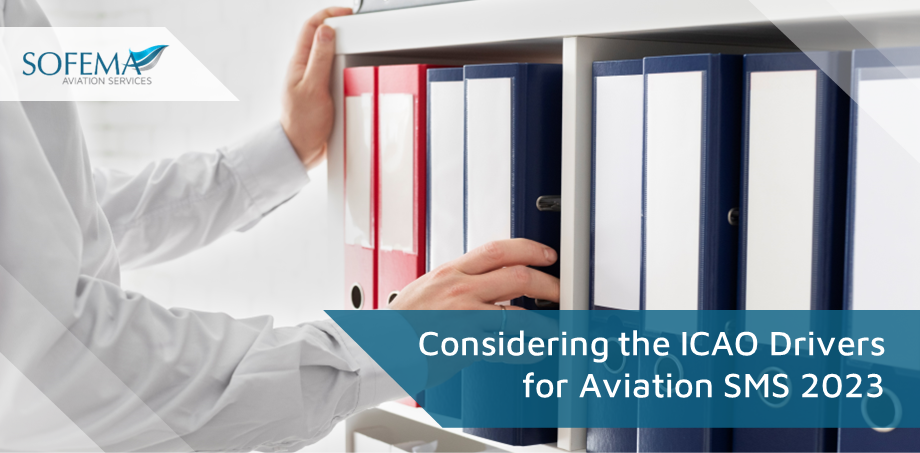Sofema Aviation Services (SAS) considers the current status and changes following the issue of the ICAO Safety Management Manual, Doc 9859, 4th Edition.
Aviation SMS 2023 – ICAO Drivers General Introduction
Aviation Safety Management Systems (SMS) are a work in progress and the standards and regulatory drivers will continue to focus on evolution and strategy to improve safety performance.
The foundation of this proactive safety strategy is based on the implementation of an ICAO-compliant State safety program (SSP) that systematically addresses safety risks.
Both EASA and the FAA are fully supportive of an Aviation Safety Management System:
- The FAA regards SMS as a critical element of its regulatory authority and safety oversight responsibility regarding increasingly diverse aviation product/service providers, including “airports, manufacturers, operators maintenance organizations, training organizations, air traffic service providers, and others;”
- EASA – Competent Authority Requirements (A/R) take due account of the critical elements of a safety oversight system defined by ICAO Annex 19:
o They include elements that are essential for establishing a comprehensive aviation safety management system at the EU level.
o These common authority requirements are directly relevant to the implementation of the European Aviation Safety Programme (EASP).
- EASA – Organisation Requirements (O/R) include consolidated general requirements for management systems. They are designed to embed the ICAO Annex 19 in a way as to ensure SMS compatibility with existing management systems and encourages an integrated management system.
- It should fit various organisations, whatever their size, nature, or complexity of activities and whatever business model they follow, thus catering to proportionate applications.
ICAO Summary of Changes Safety Management Manual, Doc 9859, 4th Edition
Ref Issue 3 which was divided into five chapters as follows:
- Overview of the Manual
- Safety Management Fundamentals
- ICAO Safety Management SARPs
- State Safety Programme (SSP)
- Safety Management Systems (SMS)
Issue 4 is now divided into 9 Chapters with expanded guidance for the new Chapters:
- Introduction
- Safety Management Fundamentals
- Safety Culture
- Safety Performance Management
- Safety Data Collection and Processing Systems
- Safety Analysis
- Protection of Safety Data, Safety Information and Related Sources
- State Safety Management Responsibilities
- Safety Management Systems
The following benefits are expected to be derived from Issue 4:
- To support a clear understanding of what safety management, effectively implemented, can achieve
- Expanded introduction to address the scope of safety management provisions and their applicability
- Guidance on applicability for State-owned or military aviation service providers
- Introduction of the notion of integrated risk management to create awareness of the impact other domains have on the management of safety risk and vice versa
- Importance of focus on overall risk reduction for the organization (State or service provider)
- Entire chapters devoted to safety culture and Protection of safety data, safety information and related sources
o Guidance on the promotion of a positive safety culture
o Basic principles governing the protection of safety data and safety information, and guidance for the implementation
- State Safety Management Responsibilities reflects the SSP with the State safety oversight (SSO) system critical elements (CEs) as the foundation of SSP
- The CEs are integrated throughout the components
- The term “framework” is no longer used in reference to SSP
- Due to the integration of the SSP elements with the SSO system, the State Safety Promotion Component is now focused on internal/external communication and dissemination of information
- Internal training of State personnel involved in the implementation of SSP is covered under Component 1 which now includes “Resources” in the title
- External training for industry is considered the responsibility of industry and is addressed under Component 2, Safety risk management as part of the acceptance of the SMS
- General guidance on the performing a Training Needs Analysis in Chapter 9 for service providers , but can also be used for States to develop inspector competencies
- Training topics for accountable executives and senior managers are provided
- General guidance on importance of a system description and identifying and managing interfaces contained in Chapter 1
- Specific guidance directed at States under SSP Implementation in Chapter 8
- Specific guidance directed at service providers under SMS Implementation in Chapter 9
- Strengthened link between safety objectives and safety performance in Chapter 4, 8 and 9
- More flexibility in how the safety performance framework is defined
- Specific guidance for States under State Safety Performance section in Chapter 8
- The linkage between ALoSP and safety performance management activities of service providers is explained
- ALoSP represents an agreement between all the State aviation authorities of the expected level of safety performance that the aviation system should deliver
Next Steps
Follow this link to our Library to find & Download related documents for Free.
Note – Sofema Aviation Services offer a training course focusing on best practices to help us embrace the various SMS challenges:
For additional questions or to register please email team@sassofia.com
Tags:
aviation, Aviation regulatory training, aviation safety, Aviation Safety Management System, Aviation SMS, EASA, ICAO, ICAO SMS, Regulatory Compliance, Risk Management, Safety Management Manual, SAS blogs, SAS training, SMS, Sofema Aviation Services, State Safety Programme (SSP)




